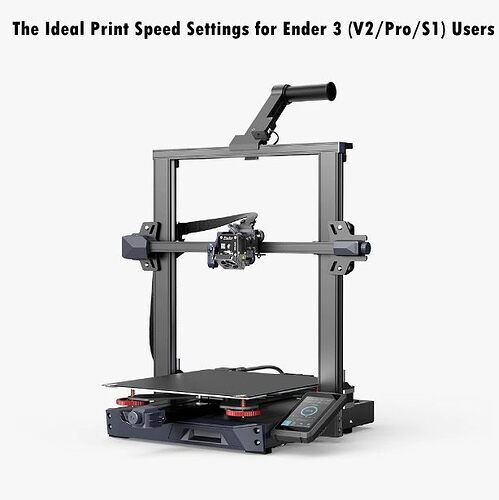The Creality Ender 3 is a popular budget 3D printer that has seen several versions released since its initial launch in 2018. Different versions of the Ender 3 offer various features, though all are capable of incredible fine-tuning when it comes to print settings.
This article specifically focuses on speed settings for the Ender 3 and its different versions, providing suggested values for each setting.
Part 1: Versions of Creality Ender 3 Print Speed
1. Ender 3 Print Speed
The cornerstone of print speed settings, “Print Speed,” dictates the overall pace of your 3D printer. Acting as a parent setting, it influences subsidiary parameters like infill speed and wall speed. For PLA on a stock Ender 3 (Pro/V2/S1), the sweet spot usually ranges from 45 to 65 mm/s. However, a widely recommended value is 60 mm/s, striking a balance between speed and print quality.
Pro Tip: Fine-tune print speed in small increments based on filament material and nozzle size.
2. Ender 3 V2 Print Speed
The Ender 3 V2 is a tremendous upgrade from the original Ender 3, sporting improved stability, quieter printing, and a more user-friendly interface. However, the recommended print speed hasn’t changed dramatically.
The ideal print speed for the Ender 3 V2 is between 50-60mm/s. This speed allows for good print quality without sacrificing much time. However, if you’re printing a complex design with intricate details, you may want to reduce the speed to 40mm/s.
3. Ender 3 Pro Print Speed
The Ender 3 Pro offers an enhanced stability and durability with its 40x40 aluminum extrusion for the Y-axis base. This leads to better printing quality.
For the Ender 3 Pro, a print speed of 50-60mm/s is also recommended for general printing. However, if you require finer details, a speed of 40mm/s can yield better results. Keep in mind that slower speeds can lead to higher quality prints, but at the cost of increased print time.
4. Ender 3 S1 Print Speed
The Ender 3 S1 is a newer model in the Ender series, and while it shares many features with its predecessors, it also offers several upgrades, such as a larger build volume and a more powerful power supply.
As with the other models, a speed of 50-60mm/s is ideal for the Ender 3 S1, but you can decrease this to 40mm/s for more detailed prints.
Part 2: Specific Speed Settings for the Ender 3
Key speed settings for the Ender 3 include the actual print speed setting, infill speed, wall speed, support speed, first layer speed, and travel speed. Each of these settings contributes to the overall speed and performance of the printer.
The print speed is a primary setting that controls the values of other speed settings. Typical print speed for a stock Ender 3 printing PLA is between 45 and 65 mm/s. Infill speed, which controls how fast the printer prints the internal filling of a model, should be in the 40-60 mm/s range. Wall speed, which controls how fast the printer prints the wall structures, should be increased from the default 30 mm/s to around 35 or 40 mm/s.
Support speed, which controls how fast support structures are printed, can be increased to 30-40 mm/s. The first layer speed, which is crucial to the success of the entire print job, should be kept at the default value. Finally, the travel speed, which controls how fast the printhead moves during non-extrusion, can be increased to 180 mm/s.
In addition to these speed settings, other slicer settings like infill density, layer height, wall thickness, nozzle temperature and retraction speed can also influence the print time and overall performance of the Ender 3.
Hot FAQs about Ender 3 Print Speed
1.What is the recommended print speed for the Ender 3 printer?
The Ender 3 printer can technically reach a print speed of up to 200mm/s. However, to ensure high-quality prints, it is recommended to use a print speed between 50-60mm/s.
2.Can increasing the Ender 3 print speed affect the quality of the print?
Yes, increasing the print speed on the Ender 3 can potentially affect the quality of the print. Higher speeds may cause issues like under-extrusion, where not enough filament is pushed through the nozzle, leading to imperfect prints. It’s always a balance between speed and quality.
3.How can I optimize my Ender 3 printer for faster print speed?
To optimize your Ender 3 printer for faster print speed, consider factors like the type of filament used, the complexity of the model, and the temperature settings. You can also experiment with different nozzle sizes and layer heights. However, it’s important to note that increasing speed may compromise the quality of the prints.
Conclusion
In conclusion, the ideal print speed for the Ender 3 series, including the V2, Pro, and S1, is generally between 50-60mm/s. However, if you’re working on a print with finer details, reducing the speed to 40mm/s can help achieve better results.
Remember, the key to successful 3D printing is balancing speed with quality, and these recommended settings should act as a baseline, not a strict rule.
